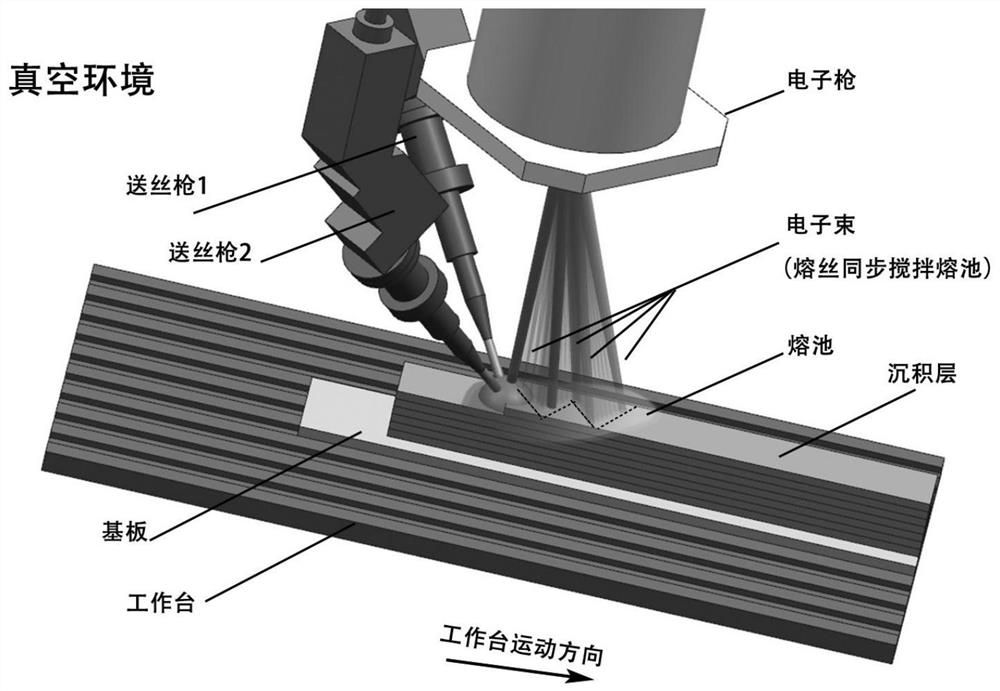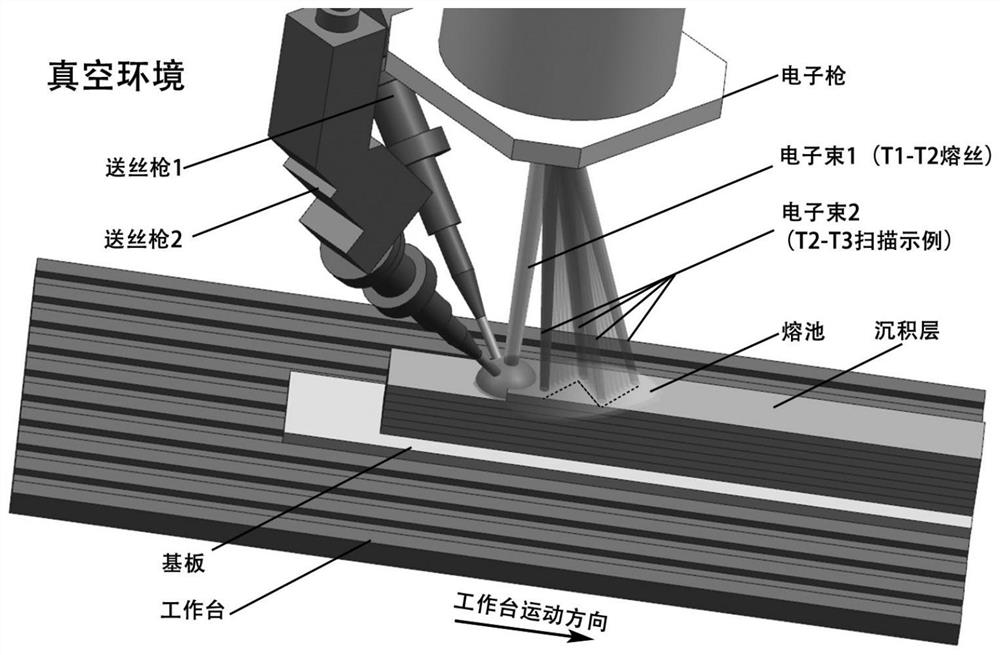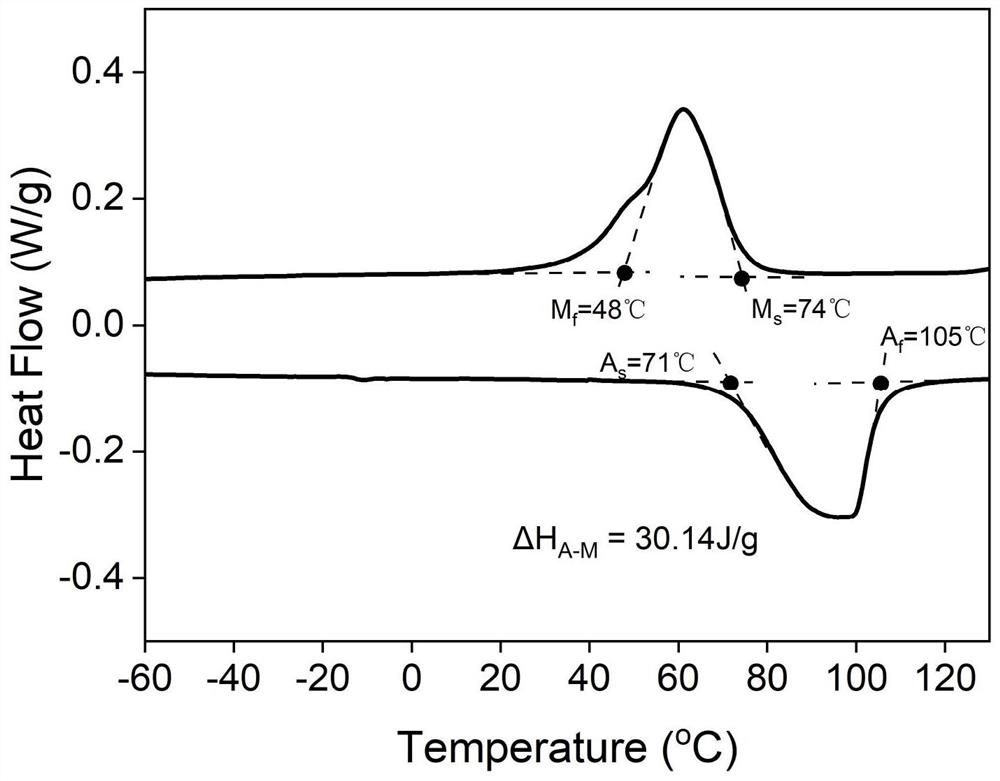Method for assisting dual wires in additive in-situ synthesis of NiTi shape memory alloy based on electron beam scanning
A technology of electron beam scanning and in-situ synthesis, which is applied in the field of additive manufacturing, can solve the problems of damage to the functional properties of NiTi alloys, low structure density, and uneven mixing of molten metals, etc., to achieve flexible and efficient preparation, high energy density, and improved The effect of uniformity
- Summary
- Abstract
- Description
- Claims
- Application Information
AI Technical Summary
Problems solved by technology
Method used
Image
Examples
Embodiment 1
[0045] This embodiment provides a method for in-situ synthesis of NiTi shape memory alloys based on electron beam scanning-assisted twin-wire additives. It includes the following steps:
[0046] (1) Carry out three-dimensional modeling and layering of the target NiTi alloy component, plan a total of 10 layers of paths, each path is a straight line of 80mm, and adopt a reciprocating printing method, that is, the end point of the first layer is the beginning of the second layer points, and so on.
[0047] (2) Select pure Ni wire with a purity of 99.99%, and pure Ti wire with a purity of 99.5% as printing raw materials, with a diameter of 2mm and a diameter tolerance of 0.02%.
[0048] (3) A NiTi alloy plate with a Ni atomic ratio of 50.8% was selected as the additive substrate, with a size of 200 mm (length) × 25 mm (width) × 15 mm (height). The surface was polished and cleaned before printing to remove impurities, so that The surface is bright.
[0049] (4) Start the equipme...
Embodiment 2
[0056] This embodiment provides a method for in-situ synthesis of NiTi shape memory alloys based on electron beam scanning-assisted twin-wire additives. It includes the following steps:
[0057] (1) Carry out three-dimensional modeling and layering of the target NiTi alloy components, and plan a total of 15 layers of paths, each path is a straight line of 70mm, and the reciprocating printing method is adopted, that is, the end point of the first layer is the beginning of the second layer points, and so on.
[0058] (2) Select pure Ni wire with a purity of 99.99%, and pure Ti wire with a purity of 99.5% as printing raw materials, with a diameter of 1.6mm and a diameter tolerance of 0.02%.
[0059] (3) A NiTi alloy plate with a Ni atomic ratio of 50.6% was selected as the additive substrate, with a size of 150 mm (length) × 30 mm (width) × 15 mm (height). The surface was polished and cleaned before printing to remove impurities, so that The surface is bright.
[0060] (4) Sta...
Embodiment 3
[0067] This embodiment provides a method for manufacturing NiTi shape memory alloy based on electron beam scanning assisted fuse additive manufacturing. It includes the following steps:
[0068] (1) Carry out three-dimensional modeling and layering of the target NiTi alloy components, plan a total of 20 layers of paths, each path is a 60mm straight line, and adopt a reciprocating printing method, that is, the end point of the first layer is the beginning of the second layer points, and so on.
[0069] (2) Select pure Ni wire with a purity of 99.99%, and pure Ti wire with a purity of 99.99% as printing raw materials, with a diameter of 1.2mm and a diameter tolerance of 0.02%.
[0070] (3) A NiTi alloy plate with a Ni atomic ratio of 51% was selected as the additive substrate, with a size of 200 mm (length) × 25 mm (width) × 15 mm (height). The surface was polished and cleaned before printing to remove impurities, so that The surface is bright.
[0071] (4) Start the equipmen...
PUM
 Login to View More
Login to View More Abstract
Description
Claims
Application Information
 Login to View More
Login to View More - R&D
- Intellectual Property
- Life Sciences
- Materials
- Tech Scout
- Unparalleled Data Quality
- Higher Quality Content
- 60% Fewer Hallucinations
Browse by: Latest US Patents, China's latest patents, Technical Efficacy Thesaurus, Application Domain, Technology Topic, Popular Technical Reports.
© 2025 PatSnap. All rights reserved.Legal|Privacy policy|Modern Slavery Act Transparency Statement|Sitemap|About US| Contact US: help@patsnap.com



